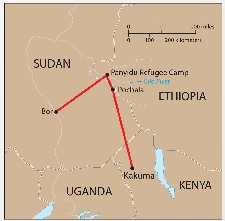landscape was like nothing they had ever experienced. As Gai told a Time magazine reporter, “I thought if the trees couldn’t survive in this place, how would we?”
In 1987, soldiers attacked Wal’s village while he was away tending his family’s herd of cattle. His entire village was killed and Wal, who was only seven years old, found himself completely alone in the world. Wal escaped and soon joined thousands of boys between the ages of four and fourteen who were in the same situation. These boys had avoided death because they had been away from their villages at the time of the attacks.
The boys walked for three months. Many died of starvation, disease, or from drowning in the deep rivers of Sudan as they fled to safety. Some were even attacked by wild animals and killed. Exhausted, the boys finally found an Ethiopian refugee camp, where aid workers named them the Lost Boys.
But their story does not end here. As time passed, the Lost Boys were forced to seek refuge in a camp in Kakuma, Kenya. There, United Nations workers provided food, education, and encouragement. By 1999, the United Nations and the United States had agreed to resettle close to 4,000 Lost Boys in the U.S., including Wal and Gai. These boys have settled in cities across the U.S. Now college-age and older, they are working hard to receive educations.

A Journey of a Thousand Miles
The Lost Boys spent three months walking from Sudan to Ethiopia. It took nearly a year before they finally reached Kenya.